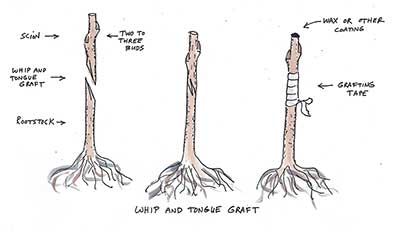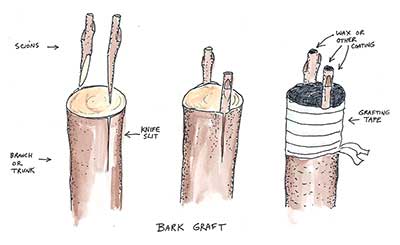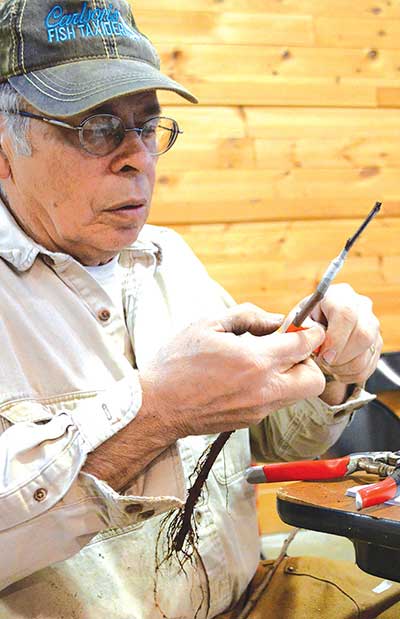 |
| Whip and tongue graft. Illustration by John Bunker |
 |
| Bark graft. Illustration by John Bunker |
 |
| Delton Curtis grafting at the Seed Swap and Scion Exchange. English photo |
By John Bunker
Not everyone knows that when you start an apple tree from a seed, it will never come true to type. If you plant a ‘McIntosh’ seed and wait about 10 years, your new tree will produce fruit, and the fruit might be delicious, but it won’t be ‘McIntosh’. Not only that, it won’t be ‘Cortland’ or ‘Honeycrisp’ or ‘Macoun’ or ‘Northern Spy’ or any other apple that’s ever been.
Every seed in every apple that ever was is like you and me. Each of us – and each of them – is a genetic combination of Mom and Dad: new and unique, every one. The fruit on a ‘McIntosh’ tree will always be ‘McIntosh’, but the seeds, no. Never. Every seed is new and unique.
If you want to reproduce a ‘McIntosh’ or a ‘Honeycrisp’ or any other variety, you must do so by grafting. When you go to a U-pick orchard, every tree you pick has been grafted. When you purchase a fruit tree at your local garden center or through the mail, you have obtained a grafted tree.
At MOFGA’s Maine Heritage Orchard (MEHO), we collect rare historic “heirloom” apples. When we locate an additional variety on an ancient tree behind someone’s old barn, we graft it. We take a tiny piece of a twig, about the size of one of those birthday candles you’d blow out at your birthday party. We splice that twig onto an existing apple tree with roots. That host is called the rootstock, or understock. The splice is the graft. The first syllable of the word “scion” is pronounced like that of the word “science.”
No one knows who invented grafting. We know only that for hundreds of years, apples have been propagated by this method. My hunch is that some “Einstein” of the past saw two branches that had rubbed against one another and fused into a natural graft, and said, “Hey, I can do that.” All you need is a very sharp knife, a bit of fabric and some goo. Those early grafters knew how to make their knives sharp. A leaf and some pine pitch would probably suffice for fabric and goo. One thing led to another, and before long primordial orchardists were selecting trees they liked, collecting scionwood and grafting it onto young trees that grew outside their caves or huts or castles.
Today we use special folding grafting knives, special grafting tape, and we buy a bottle of goo. The process, however, remains the same. While trees are dormant, we cut the scions. Then right about now, we graft the trees onto rootstock using what we call a “whip and tongue” graft. Later, in early May, we “topwork” graft existing trees in the orchard. Topworking enables us to alter the variety of an undesirable tree or add varieties to a tree. When you topwork, you can install a different variety on every branch.
If the graft succeeds, we say that it “takes.” The process is a way to pass apple varieties from generation to generation over large spans of time. Some of the varieties in the Maine Heritage Orchard originated from a seed hundreds of years ago. Someone noticed that a particular seedling had some superior quality. Perhaps it kept all winter in the root cellar, ripened in July, or made a great pie or tasty cider. The person snipped a piece of scionwood, grafted it, named it and passed it around the village or the county or the state. A few became known far and wide, while others remained locally adapted favorites.
Passing the scionwood is like passing the baton in a relay race. We stand in the middle. We meet the ancient apple tree. If we choose to do so, we can cut a twig from that tree and then hand it off to the future by grafting. We take that gift from the past and we pass it on to the future.
The baton will be passed once again on Sunday, March 31, 2019, from 10 a.m. to 3 p.m., when MOFGA will host the annual Seed Swap and Scion Exchange in Unity. Orchardists, enthusiasts and the curious will gather to partake is this age-old tradition. We’ll have knives, tape, goo and rootstock for sale, and donated piles of scionwood free for the taking. Grafters will be on hand to graft a tree for you right on the spot, the proceeds of which will help support the MEHO and its orchard educational programming. Come join us and see what it’s like to pass along the gift of life once again from the past to the future.
When John Lennon described the work he was doing, shortly before he died, he could have been describing what anonymous grafters have been doing for hundreds of years as they passed along apples to the next generation through the art of grafting: “… we’re carrying that torch, like the Olympic torch, passing it hand to hand, to each generation … and that’s our job.”
